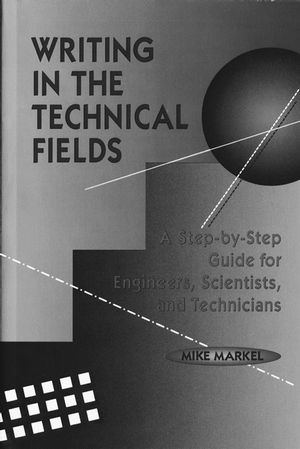Writing in the Technical Fields: A Step-by-Step Guide for Engineers, Scientists, and TechniciansISBN: 978-0-7803-1036-0
Paperback
296 pages
March 1994, Wiley-IEEE Press
 This is a Print-on-Demand title. It will be printed specifically to fill your order. Please allow an additional 10-15 days delivery time. The book is not returnable.
|
||||||
Preface xiii
Part I: Techniques 1
Chapter I. Introduction 3
Treat Workplace Writing as a Craft, Not an Art 3
Unlearn What You Learned in School 4
Focus on What You Know About Writing at Work 6
Characteristics of Effective Workplace Writing 7
Chapter 2 Before You Start Writing 13
Use Short Writing Sessions, Not Long Ones 13
Write Collaboratively 15
Analyze Your Audience 17
Define Your Purpose 18
Evaluate the Implications of Your Audience and Purpose 19
Make Sure Your Boss Agrees with What You've Decided 21
Chapter 3. Understanding the Writing Process 23
Generate Ideas to Include in the Document 23
Organize Your Information 26
Write the Draft Quickly 34
Spend Your Time Revising 34
Chapter 4 Using the Computer to Improve Your Writing 39
Understand What the Computer Can—and Cannot—Do for You 40
Use the Computer When You're Just Getting Started on a Document 40
Use the Computer When You're Drafting 41
Use the Computer When You're Revising 42
Use Specialized Software 43
Chapter 5. Improving the Coherence of Your Writing 47
Write Informative Titles and Headings 48
Use Lists to Communicate Parallel Information 50
Use Introductions to Forecast Discussions 52
Use Conclusions to Complete Discussions 55
Chapter 6 Writing Better Paragraphs 59
Begin with a Clear Topic Sentence 59
Support the Topic Sentence Logically 61
Emphasize the Coherence of the Paragraph 62
Keep Paragraphs to a Manageable Length 65
Chapter 7. Writing Better Sentences 67
Determine the Appropriate Stylistic Guidelines 68
Use the Active and Passive Voices Appropriately 68
Choose Appropriate Sentence Patterns 70
Focus on the Real Subject 72
Focus on the Real Verb 73
Use Modifying Elements Effectively 74
Keep Parallel Items Parallel 76
Chapter 8 Choosing the Right Word 79
Choose Simple, Clear Words and Phrases 79
Avoid Unnecessary Jargon 82
Avoid Euphemisms 82
Avoid Cliches 82
Avoid Sexist Language 83
Use Readability Formulas Carefully 84
Chapter 9 Creating and Integrating Graphics 87
Determine Whether You Need Graphics 87
Determine What Kind of Graphic to Use 89
Make the Graphic Honest 90
Make the Graphic Self-Sufficient 91
Determine Where to Put the Graphic 95
Tie the Graphic to the Text 95
Chapter 10. Improving Page Design 99
Leave Adequate Margins 100
Consider a Multicolumn Format 101
Use Appropriate Line Spacing 102
Use Appropriate Justification 104
Understand the Readability Levels of Type Fonts 106
Use the Different Members of a Type Family 107
Use Type Sizes Appropriately 108
Use Uppercase and Lowercase 110
Design Titles and Headings for Emphasis and Clarity 110
Design Lists for Clarity 112
Part II: Applications 115
Chapter 11. Letters 117
Learn the Standard Letter Formats 117
Learn Letter Protocol 118
Forecast the Purpose of the Letter 122
End on a Positive Note 123
Achieve a Natural Tone 124
Chapter 12 Memos 127
Create an Informative Heading 128
State the Purpose Up Front 128
Include a Summary 129
Conclude with an Action Statement 130
Chapter 13. Minutes 135
Include the Necessary Housekeeping Details 136
Record Events Accurately 136
Record Events Diplomatically 137
Chapter 14 Procedures and Manuals 141
Emphasize Safety 142
Orient the Reader 145
Write Clear Instructions 148
Add Graphics to Clarify the Text 150
Design the Document for Easy Use in the Field 152
Anticipate the Need for Updates 154
Include Troubleshooting Tips 154
Chapter 15. Formal Elements of Reports 157
Transmittal Letter 158
Title Page 160
Table of Contents 160
Abstract 162
Executive Summary 164
Appendices 166
Chapter 16 Proposals I69
Plan Before You Start Writing 170
Show That You Understand the Readers’ Needs 171
Propose a Clear, Specific Technical Plan for the Project 174
Demonstrate Your Professionalism and Credibility 176
Use Graphics to Help Your Readers See Your Ideas 177
Evaluate the Proposal Carefully Before You Send It Out 178
Chapter 17. Progress Reports 183
Clarify the Context 183
Explain the Progress Clearly 184
Explain the Progress Honestly 185
Chapter 18. Completion Reports 189
Introduce the Report Clearly 190
Describe Your Methods 191
Present Your Results 192
Draw Conclusions from the Results 194
Present Your Recommendations 195
Appendices 197
A. Checklists 199
B. Handbook 207
C. Commonly Misused Words and Phrases 241
D. Guidelines for Speakers of English as a Second Language 247
E. Guidelines for Writing to Speakers of English as a Second Language 261
F. Selected Bibliography 265
Index 271



